If you’ve ever wondered about the different types of lines in art and how they can enhance your creativity as an artist, you’re in the right place.
In the world of art, there are five primary types of lines: vertical, horizontal, diagonal, zigzag, and curved lines.
Each type carries its own meaning and can be used strategically to convey different emotions or messages in your artwork.
By understanding these types of lines and their functions, you can unlock endless possibilities for your artistic expression.
So, let’s dive in and explore how you can leverage these lines to your advantage in your creative journey!
What Is A Line In Art?
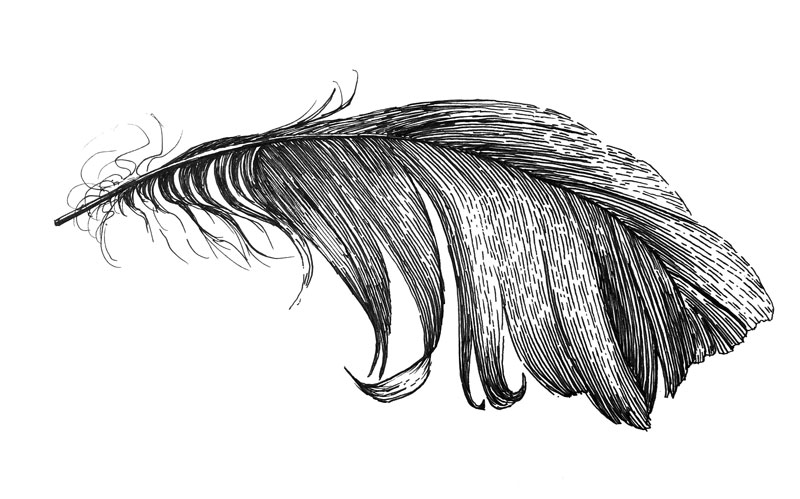
In the world of art, a line is like a journey of a point moving through space.
Imagine it as the simplest building block of art. Just like how a story starts with a single word, art often starts with a line. It’s like connecting the dots, quite literally!
Lines are super important because they’re the foundation of pretty much everything you see in art. They come together to form shapes, define boundaries, create patterns, and express emotions. Without lines, art would be like a puzzle missing its pieces – incomplete!
So, whether it’s a bold stroke or a delicate curve, lines are the storytellers of art, guiding us through the creative journey one mark at a time.
The Origins of Line Art Drawing

The history of line art stretches back over 70,000 years, with the earliest known human drawing found in South Africa on a rock flake.
This drawing, made with red ochre, consisted of criss-crossed lines. Since then, line art has evolved significantly.
Famous artists like Pablo Picasso and Leonardo da Vinci used line art as a preliminary step in their creative process, often as studies before creating painted masterpieces.
Picasso’s early works can be found in places like the Picasso museum in Barcelona, offering insights into his artistic journey.
For some artists, like Keith Haring and Shantell Martin, line art is their primary form of expression.
Haring gained fame for his vibrant chalk line drawings, often seen in New York City subways, which addressed social issues like AIDS and homosexuality.
Martin, on the other hand, creates large black-and-white drawings in front of live audiences, a process she calls “liveography.”
Her work has been featured in prestigious places like Vogue Magazine and Miami’s Art Basel.
These artists show that line art isn’t just a technique but a powerful form of expression, used to convey messages, emotions, and ideas across different mediums and platforms.
7 Principles of Art

Here are the seven commonly recognized principles of art:
- Balance
- Contrast and Emphasis
- Movement and Rhythm
- Unity and Variety
- Harmony
- Pattern
- Proportions and Scale
7 Elements of Art

You are currently learning about Lines – one of the Elements of art.
There are in total 7 elements of art which are mentioned below:
Types of Lines in Art
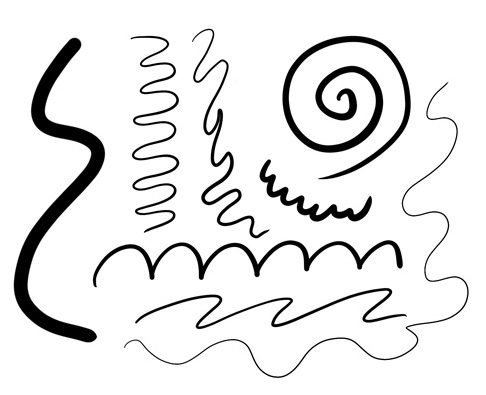
Horizontal Lines
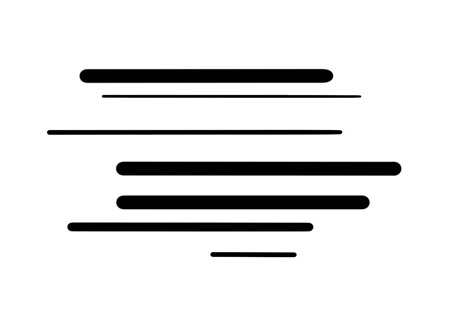
Horizontal lines in art, whether straight or subtly curved, travel across from left to right or vice versa. They’re akin to the flat and parallel lines we see at the horizon, where the sky meets the earth or ocean.
These lines create a sense of distance and space, often giving artworks a feeling of depth. Think of looking down a long road or across a vast field – that’s the kind of space horizontal lines can evoke.
“The Monk by the Sea” by Caspar David Friedrich paints a clear picture of the horizon, where the sky meets the sea. It’s not just about depicting the scene; it’s about conveying a sense of vastness and tranquility through those horizontal lines.
Vertical Lines

Vertical lines in art convey a sense of rising upwards or falling downwards, standing perpendicular to the earth’s surface.
They are often associated with strength, power, and spirituality, and they enhance the prominence and height of subjects in artwork.
An iconic example of vertical lines can be seen in the soaring spires and pointed arches of Gothic cathedrals across Europe, such as the Notre-Dame de Paris, completed in 1345.
These architectural marvels exhibit the verticality that characterizes the style, imparting a sense of grandeur and transcendence.
Diagonal Lines

Diagonal lines in art are like slanted lines that lean in a certain direction, either left or right. They bring a feeling of movement and energy to a picture because of their tilted angle.
Artists use diagonal lines to draw focus to particular points or to make a flat image appear more lifelike and deep.
For example, in Gustave Caillebotte’s painting “Le Pont de l’Europe,” from 1876, a bridge forms a diagonal line on the right side, making the scene feel active and lively.
Curved Lines
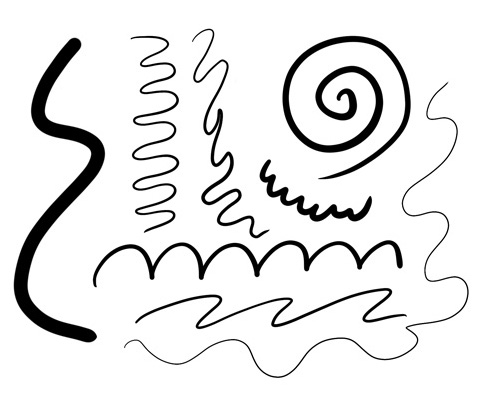
Curved lines in art are like the graceful bends or waves you might see in a river or in the wind.
They can be as smooth as a gentle breeze or as intricate as the twists and turns of a vine.
These lines often give a sense of movement and flow, almost like they’re dancing across the page or canvas.
One famous example of curved lines in art is Vincent van Gogh’s painting “The Starry Night.”
If you look closely, you’ll notice how the swirls in the sky and the flowing lines of the hills create a sense of motion and energy, drawing you into the scene.
Zigzag Lines
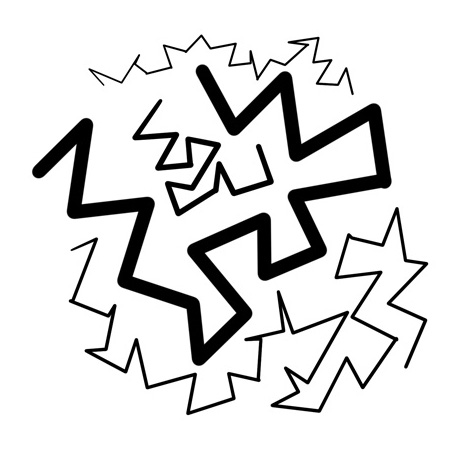
Zigzag lines in art are like jagged lightning bolts streaking across a canvas.
They’re sharp, angular, and full of energy, moving up and down with a sense of urgency. These lines stand out boldly, creating a dynamic contrast to more gentle curves.
Artists use zigzag lines to add excitement and movement to their work. Whether it’s a simple pattern or a complex design, zigzags bring diversity and interest to the piece.
Take, for example, Solomon LeWitt’s Wall Drawings series, where zigzag lines dance across walls, captivating viewers with their lively rhythm.
How to Get Variations of Lines in Art?
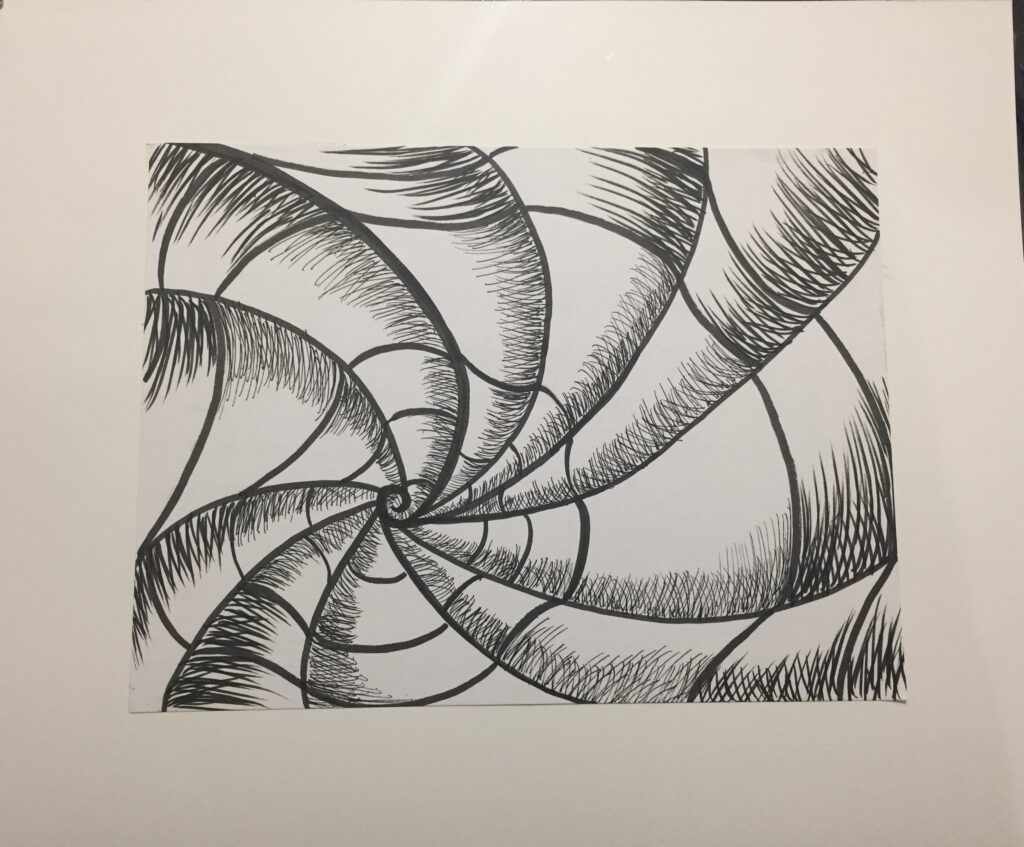
To create different kinds of lines in art, you can play around with various aspects like length, width, weight, texture, style, and direction.
Let’s break it down:
- Length: Lines can be long or short. Long lines give a sense of distance or strength, while short lines feel closer or more compact.
- Width: Lines can vary in thickness. Thin lines are delicate and lightweight, while thick lines convey strength and power.
- Weight: This refers to the variation in width along the line. Changing weight can capture movement, energy, and depth, suggesting objects in the foreground or background.
- Texture: Lines can be smooth or rough. Changing texture might mean switching between different drawing tools or mediums, like going from markers to charcoal or adjusting digital brushes.
- Style: Lines can be continuous, dotted, dashed, or implied. Continuous or implied lines guide the viewer’s eye, while dashed or dotted lines create patterns and draw attention.
By combining these variations, you can create lines that are unique and serve a specific purpose in your artwork.
Experimenting with these elements allows you to express different feelings, movements, and textures in your art.
Types of Lines in Art Defined by Their Use
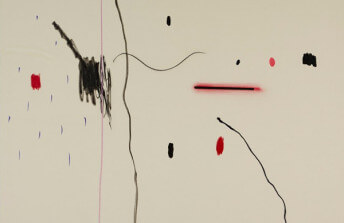
Types of lines in art can be classified based on how they’re used in an artwork.
Let’s break it down:
- Contour Lines: These lines define the outline of a shape, whether it’s the outer edge or within the shape itself. They’re like the boundary lines of a figure or object. Artists might keep the width consistent for a clean look, or vary it to add energy and depth.
- Continuous Line: Imagine drawing something without ever lifting your pen from the paper. That’s a continuous line. It’s a single, unbroken stroke that can create expressive and lively artwork. However, if not done carefully, it might end up looking messy.
- Parallel or Cross-Hatching Lines: These lines are used to add texture, volume, shading, or patterns to a drawing. By layering lines parallel or crossing over each other, artists can create different tones and shadows. The closer the lines are, the darker the area appears.
- Gesture Lines: Quick, fluid lines that capture the movement and form of a subject, especially the human figure. Gesture drawing, typically done in short sessions of 30 seconds to 5 minutes, aims to convey energy and motion.
- Implied Lines: These lines aren’t physically drawn but are suggested by other elements in the artwork. They’re like invisible guides that direct the viewer’s eyes where the artist wants them to go. Implied lines are a powerful tool for guiding composition and focus.
Each type of line serves a different purpose in art, from outlining shapes to capturing movement or guiding the viewer’s gaze. Artists often use a combination of these lines to create dynamic and engaging compositions.
Functions of Lines in Art and Design
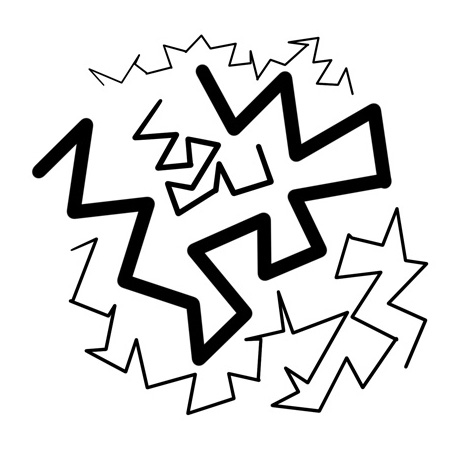
In art and design, lines serve various functions that are crucial to the creation and understanding of visual works.
Let’s delve into the key roles lines play:
- Identification: Lines are fundamental in capturing the essence of a subject. By arranging lines in certain ways, our brains can easily recognize objects or figures. Think of it as drawing the outline of something to represent it.
- Three-dimensional Space: Lines help convey depth and space in artwork. By varying the characteristics of lines such as tonality, width, and intensity, artists can create the illusion of objects being near or far. Lighter and thinner lines typically suggest distance, while darker and thicker lines appear closer.
- Organization: Lines aid in structuring and organizing compositions. In the initial stages of creating art, artists often use lines to sketch out their ideas and define the layout of elements. Lines can separate or group elements on a page, helping to establish the foreground, middle ground, and background.
- Movement: Lines guide the viewer’s gaze and create a sense of flow or direction within a piece of art. Artists use various techniques such as changing the width or direction of lines to lead the viewer’s eyes in a desired path. This function is especially important for capturing movement within a static image.
- Texture: Different variations of lines can imply textures within artwork. Smooth textures may be represented by straight or curved unbroken lines, while rough or messy textures can be achieved using different tools or techniques. Specific patterns of lines can evoke textures like fur or woodgrain, adding depth and realism to the artwork.
Effective Ways to Use Lines

Understanding how to effectively use lines in your artwork can greatly enhance its impact and communicate specific emotions or themes.
Before laying down a line, consider the message or feeling you want to convey.
Here are some tips for using lines effectively:
- Match the Lines to the Mood: If you’re aiming for a lively and energetic piece, opt for curved lines with varying thickness and texture. These lines can convey movement and dynamism, adding excitement to your artwork.
- Create Tranquility with Organized Shapes: For artwork that exudes peace and serenity, start by organizing your composition with large, simple shapes. Then, incorporate gentle, flowing lines and embrace minimalism to evoke a sense of calmness and harmony.
- Express Anxiety with Jagged Lines: If your intention is to depict anxiety or tension, consider using cross-hatching, zig-zags, and diagonal lines. These jagged and irregular lines can create a sense of unease or agitation, effectively conveying the emotional turmoil you want to express.
Conclusion
In essence, lines in art are the silent narrators of creativity, weaving stories and emotions onto the canvas.
From the ancient criss-crossed lines on a South African rock to the vibrant chalk drawings in New York subways, artists have harnessed the power of lines to convey messages, evoke feelings, and capture the essence of their subjects.
Whether it’s the vastness of horizontal lines, the strength of verticals, the dynamism of diagonals, the flow of curves, or the vitality of zigzags, each type of line offers a unique avenue for artistic expression.
By understanding their variations and functions, artists can effectively guide movement, convey mood, and create texture in their work.
Lines are not just strokes on a canvas; they’re the building blocks of imagination, waiting to be shaped and molded to tell your story to the world.
So, embrace the power of lines, experiment with their versatility, and let them guide you in unlocking the full potential of your creative vision.

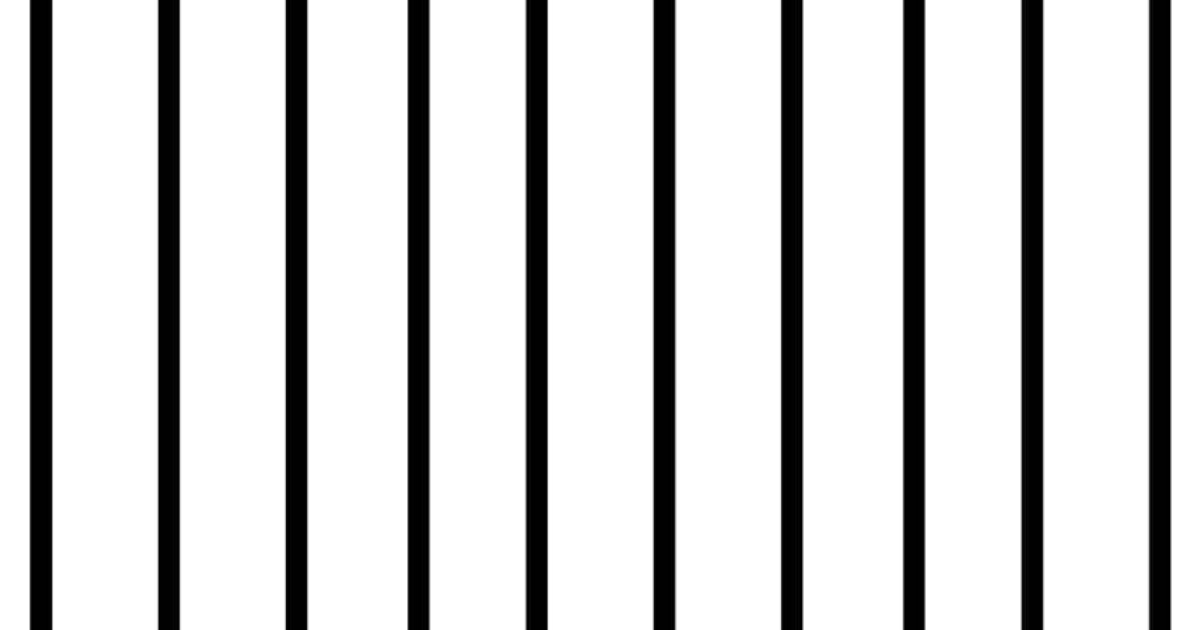
Leave a Reply